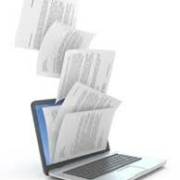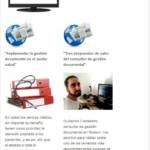10 tips to apply document management in your company
In this post, we give you 10 tips for document management in both companies and public administrations. These tips, although they may seem obvious, are not yet applied properly, so let’s remember them.
1. We must take into account, it is the type of document we make and its “life cycle” . For example, it is a classic that, from a phone call, we take notes on a piece of paper and then transfer that information to the computer. We already have two formats with the same information and we are doing repetition of work, so we are not being productive. Also, what do we then do with that piece of paper with information about a customer or contact? Throwing it away, as it is, in the trash, let’s say that it would not be the most correct thing if we want to comply with data protection and audit processes. Realistically, today, eliminating paper is still a difficult goal, which is why we can create internal processes for the flow of responsibility or action with these documents to digitize them.
2. We must also take into account the facilities we have to store the information. The rooms where they are stored must have optimal temperature conditions , be fireproof, and have their own fire-fighting system. In the same sense, the room must have restricted access to authorized personnel to avoid damaging something by mistake or fraudulent use.
3. Commitment to confidentiality and availability of the files according to the permissions for each case (type of document, person who needs it, use that is going to be given to it, etc.) and also to verify that the documentation is authentic.
4. Properly classifying information and facilitating its retrieval is an important part of document management. It must be an agile system that saves search time .
5. Create a workflow
according to your business rules, to assign responsibilities, processes, determined times in each document management process. For example: determining that when certain documents arrive at the office they are classified and digitized by a certain department or another, depending on the value of that document.
6. You will make daily backups and in different systems, such as hard drives or remote systems, which guarantee that, if there is a theft, a hacking of the systems, all the information can be recovered quickly.
7. Implement security levels based on the type of documentation . You must also have a record of the people who access the system and its use, control its traceability.
8. Train staff so that they know the importance of proper use of data and its management. Promote good habits in the treatment of documentation to also comply with the data protection law.
9. Use the technology available to us to safeguard the documents. 3 points must be taken into account: Digitization (document management system), the cloud (save this information remotely) and accessibility (from the Internet).
10. Have controlled all the vulnerabilities or threats that may exist. Having an action protocol for each situation will help us avoid unforeseen events and ensure that the information is always protected.
In order to apply these points, it is very important to have the awareness of the directors of the companies of the public administrations, in order to transmit this importance to the staff and get them involved. A good document management system, as well as the help and support of a documentalist or document management consultant, will make the digitization process easy and understandable for everyone.









